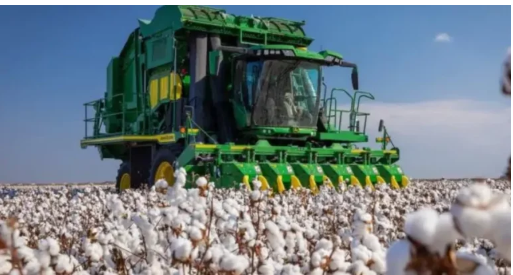The Cotton Combine is combining processing with harvesting.
The Cotton Combine is combining processing with harvesting. For millennia, cotton has been a staple crop forming the backbone of textile companies all throughout the world. From garments to home furniture, this natural fiber is vitally vital in our daily existence.

Understanding Customary Cotton Harvesting Techniques
Before the cotton combine, cotton harvesting was a multi-stage operation requiring a lot of hand labor and machinery at multiple steps. Usually, the operation began with field harvesting, that is, hand laborers or mechanical pickers gathering the cotton bolls from the plants.
Following harvest, the raw cotton was sent to a ginning facility where the seeds were extracted from the fibers—a crucial step in preparing cotton ready for textile production. The ginning operation comprised numerous machines and careful management to ensure optimal performance. After ginning, the cotton was washed, baled, and sometimes graded before being shipped to textile mills for final usage as yarns and textiles.
Results of this disconnected system were higher running costs, inefficiencies, and delays in cotton to market delivery. Multiple handling sites also increased the risk of contamination and fiber damage.
Together: Changing Cotton Harvesting
Designed to address these inefficiencies, the cotton combine aggregated significant stages of cotton harvesting and processing into one, perfect tool.
As a traditional combine harvester changed grain farming by combining harvesting, threshing, and winnowing, the cotton combine combines gathering and ginning into one continuous process.
The cotton combo is essentially made of advanced mechanisms allowing it to:
- Directly from the field, gently pull the cotton fibers from the plants using high-speed spindles or suction devices to avoid too much harm.
- Sort seeds from threads.
- Many cotton blends have cleaning techniques meant to remove moisture and plant waste, therefore improving the quality of the cotton fibers and reducing their contamination potential.
- Perfect for large modules or bales, the cleaned and ginned cotton is compacted straight on the field ready for transmission to textile manufacturers.
- For cotton growers, this integration offers efficiency, greater fiber quality, and major cost savings.
Benefits of Cotton Combine
Not merely a piece of machinery, the cotton combine represents a major development for the cotton industry. Let’s delve more specifically on the primary benefits:
One gains better harvesting efficiency here.
Combining processing and harvesting helps the cotton cut demand for multiple field trips between the gin and the crop.
This streamlines the whole process so that farmers may collect more cotton in less time. From this, higher output during peak harvest seasons follows; this is rather essential in preventing agricultural losses linked to weather.
Reduced Workers Demand
Labor shortages are a key worldwide agricultural industry issue. The cotton combine reduces dependency on human labor since less people are required to run the machine than in traditional harvesting and ginning processes.
Manufacturers find reduced costs and more operational consistency as a result of this drop in personnel needs.
Improved Quality of Fiber
The integrated design of the cotton combine reduces the handling of cotton, therefore reducing the risk of fiber contamination, breakage, or compaction.
ecological and environmental benefits
The cotton combine supports more ecologically friendly farming practices by reducing fuel use, decreasing soil compaction from many field passes, and thereby lowering carbon emissions.
Further encouraging environmental stewardship, several new combines feature precision agricultural technologies such GPS and yield mapping, which assist farmers to maximize inputs including fertilizers and irrigation.
Financial Saving
Combining processing and harvesting on one machine reduces the need for other equipment, lowers transportation costs, and lessens downtime between ginning and harvesting.
Although the initial outlay in a cotton combine could be significant, long-term savings on labor, tools, and maintenance usually exceed the upfront costs.
Problems and Challenges and Consideration
There are challenges in using a cotton combine even with its benefits. Farmers have to consider whether the long-term benefits outweigh the initial purchase cost, which might be somewhat substantial. The complexity of the integrated system could potentially affect maintenance and repair costs.
Moreover, the cotton mix might not be appropriate for every farm or size of space. While large-scale commercial farms are more likely to gain from the efficiency of the combine, smaller farms with less output could find conventional techniques more affordable. Whether one should invest in a cotton combine depends on careful evaluation of field conditions, crop varieties, and market access.
The Prospective Evolution of Cotton Harvesting
Future incarnations could call for. Artificial intelligence (AI) and machine learning: Advanced AI algorithms could let cotton combines change harvesting parameters in real time depending on field conditions, hence raising production and quality.
>With cotton combines of the future interacting seamlessly with farm management software, growers may track field performance, review yield statistics, and maximize future planting and harvesting techniques.
>Combining low-emission engines, alternative fuels, and energy efficiency improvements might mix the cotton and produce an even more ecologically friendly option.
In summary
The cotton combination is an amazing creation redefining cotton production and handling. Combining initial washing, ginning, and harvesting into one machine gives cotton growers unheard-of fiber quality, cost savings, and efficiency. Although there are still challenges, mostly related to investment and adaptation to particular farm requirements, the long-term advantages of using a cotton combine are very significant.
The cotton combination honors the ability of agricultural innovation as the cotton industry keeps growing. It stands as a link between history and modern technologies, one that might lead cotton growers all over to a more sustainable, rich, and quick future.
